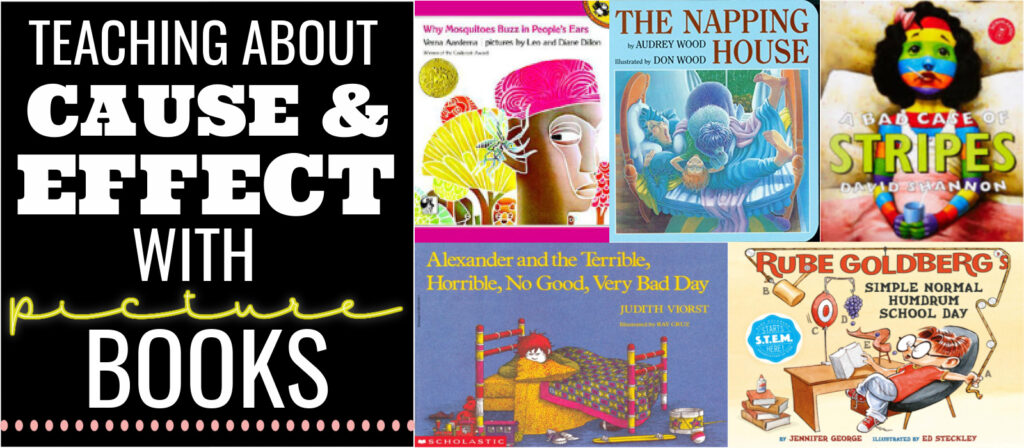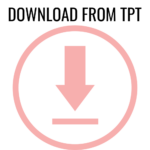Do you ever say to your children, “If you don’t wash your hands, you will spread germs to your classmates.” or “If you finish your work early you can go outside.”? As teachers, we use cause and effect language every day however that doesn’t mean children fully understand the concept.

We teach cause and effect with everyday activities, but we often don’t think about this as intentional teaching!
So, what is cause and effect?
The cause is WHY something happens, and an effect is WHAT happened. Teaching cause and effect helps children academically but also with everyday life. Mathematics and science have much to do with cause and effect. And literacy would be boring without it because the stories would not be nearly as interesting. Helping children to tune into the language of cause and effect will help them to notice that it is a part of our daily world.

Picture books are a wonderful way to engage in a discussion about cause and effect because the illustrations support the meaning of the text and show cause and effect in action. Start with a picture walk to open a discussion around the key cause and effect moments. Reinforce that CAUSE is why something happened, and EFFECT is what happened.
FICTION TITLES TO TEACH CAUSE AND EFFECT
Any of the books in the “If you give” series written by Laura Numeroff and illustrated by Felicia Bond A natural extension of any one of these books is to give each child in the group something from the classroom…a pencil, scissors, a book, a marker or crayon… and then they can write and draw modeling from the book’s pattern. “If you give Michael a pencil, he will ____________.” This can become a class book or bulletin board.
Why Mosquitoes Buzz in People’s Ears written by Verna Aardema, and illustrated by Leo and Diane Dillon This is a great book to explore either in book form or the audio version with James Earl Jones as the reader or both. It is a wonderful example of the use of the cue words for this reading skill. You can ask children to put highlight tape on examples of the cue words in a book for others to notice after you have modeled how to do this. If you use the audio version, you can ask children to jot down the cue words they hear in the story as they listen
Alexander and the Terrible, Horrible, No Good, Very Bad Day written by Judith Viorst and illustrated by Ray Cruz This book models cause and effect without the cue words with multiple examples of why it was a terrible day for Alexander. It is more complex than the other books because there are no cues and multiple reasons for the bad day. This book is very relatable for children since it is a first-person narrative.
The Napping House written by Audrey Wood and illustrated by Don Wood The illustrations in this book provide a very clear visual impression of this reading skill. This is a great book to put into a building or housekeeping center in a preschool classroom after the children have heard the story several times. They can act out what happened in the story using blocks and toys to recreate the story.
Any of the books in the “David” series written and illustrated by David Shannon These very simple books for young children provide many examples of cause and effect with simple language and illustrations that carry the story. Using the pictures, the children can tell what is happening to David in their own language and practice using the cue words you have introduced.
A Bad Case of Stripes written and illustrated by David Shannon This more complex David Shannon book is another example of a personal narrative that children can use to explore this reading skill. The great thing about this book is not only can you explore cause and effect but also teaches about being yourself and not worrying about what other people think. This is a great book for the beginning of school in second grade because of the lesson to be learned about being yourself and you can use it as an informal assessment to understand what the children know about cause and effect.
Rube Goldberg’s Simple Normal Humdrum School Day written by Jennifer George and illustrated by Ed Steckley This cartoon style book is a series of vignettes about wild inventions to accomplish simple tasks. There are closing notes in the book for STEM activities to do in class that provide concrete examples of cause and effect. This book is a good bridge between fiction and non-fiction texts.
NON FICTION TITLES TO TEACH CAUSE AND EFFECT
Henry’s Freedom Box: A True Story from the Underground Railroad written by Ellen Levine and illustrated by Kadir Nelson This biography is a great read aloud example for a discussion of cause and effect in someone’s life during the time of slavery in our country. I would recommend using this book as a read aloud because discussion is essential for the topic. While it is a picture book the reading level of the text and concept load for the topic is most appropriate for third or fourth grade.
The Case of the Vanishing Little Brown Bats: A Scientific Mystery from the Sandra Markle’s Science Discoveries Series This book is a great piece of informational writing written as a mystery about why bats are disappearing and why we don’t want that to happen. It is a great example of cause and effect in our modern world as it offers solutions for solving the problem presented. If you wanted to “pair it” with a fiction text, it goes well with Stella Luna by Janell Cannon. The fiction text supports this structure since the bat in the story gets adopted by birds when she gets lost.





Leave a Reply